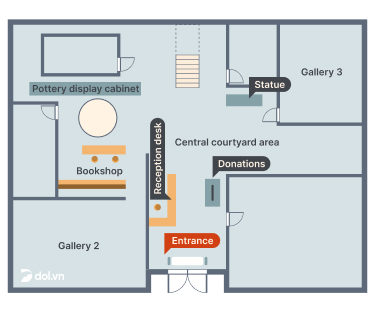Tutor:
Hello Sam, come in and sit down ...
Tutor:
You’re here to discuss your company-based IT project aren’t you?
Sam:
Yes ... I’ve been to see the Manager and he’s given me a lot of ideas about projects that the company would find useful. But I wanted to ask your opinion about them before I choose one.
Tutor:
Yes, that’s fine. Now this company’s called Turners isn’t it?
Sam:
That’s right. It’s a small engineering company - they make machine components for trade use. They’re well established - they started in nineteen seventy-six - but they’re a bit old fashioned.
Tutor:
OK ... And what kind of projects did Turners suggest you could do for the company?
Sam:
Well, they want some improvements made to their customer database. The one that they’ve got at the moment isn’t very useful in some ways. I had a quick look at it ...
Tutor:
That would be a very straightforward project, and it’d be simple enough to evaluate, but I don’t think you’d get enough out of a project like that. You wouldn’t learn anything new.
Sam:
Well another project they suggested is to do with their online sales catalogue. At the moment customers can look at their products but they can’t actually order them online, which must affect their competitiveness. But I said I thought it would take too long, it’s quite a big task.
Tutor:
You’re right. It’s too much for the time you’ve got. It’s a pity though.
Sam:
Then they want some help with their payroll system. At the moment the way they calculate pay involves a lot of manual accounting. I suggested they could have a system where employees register electronically when they arrive and leave work, so the hours they do could be transferred automatically.
Tutor:
I think you’d get a lot out of a project like that - it would extend your skills but it wouldn’t be too much to take on. A student did something similar a couple of years ago, but this is slightly different.
Sam:
Well, then they need help with their stock inventory. They do everything manually ...
Sam:
Yes! And it takes so much time.
Tutor:
It’s probably very inaccurate too ... An electronic inventory would probably be the biggest single benefit for the company. I’m surprised they haven’t had it done before.
Sam:
I know! Then they wanted to improve their internal security. The Manager had visited other companies where the staff use swipe cards to access various areas of the building ... It sounded useful, but the trouble is, I’m not really sure how to do it.
Tutor:
Well, I think you’re right in that assessment. At the moment it’s probably a bit beyond your level of knowledge. Is that all?
Sam:
Just one more ... Customer Service. They want to be able to collect feedback from their customers in a more systematic way. At the moment it’s a bit of a mess, and they probably lose business as a result.
Tutor:
Would that involve you going to see customers at their own premises? Because in that case you might have to do a fair amount of travelling, and that would incur expenses that haven’t been agreed with these companies.
Sam:
I never thought of that ...
Tutor:
Well it might not be a problem, but it’s something that needs clarifying ... Well I hope that’s been helpful in narrowing down the options?
Sam:
Yes it has, thanks. I’ll be able to make a decision now. But while I’m here, can I talk to you about coursework?
Sam:
I’m not very happy about the way our group assignment is working. There are some problems .
Tutor:
Oh dear. Are people just not getting on with each other? That’s the worst thing ...
Sam:
Actually we’re all friends, it’s not that, but when we’re having a discussion about the assignment one or two people end up doing all the talking, and the rest don’t say anything. It’s a bit frustrating, because we need plenty of debate ...
Tutor:
Well that’s a common observation. You’re studying in a group with people from all over the world, and you all have your own ways of participating. In some places students are more used to listening than talking, and vice versa.
Sam:
Mmm. I suppose you’re right ... I’ll try to remember that ...
Tutor:
Does everyone pull their weight as far as sharing the workload is concerned?
Sam:
I’d say they do, yes. And our group elected a leader. She’s very good at making sure no one’s overloaded ... But personally I feel that there are just too many of us in the group. Whenever we try to arrange a meeting there’s always at least one person who can’t make it. It’s not anyone’s fault. It’s just that we’ve all got slightly different timetables.
Tutor:
Well I’m glad you’ve talked to me about it. Feedback is always useful. Is there anything else you’re concerned about?
Sam:
There are a couple of problems with lecturers that all the students are talking about ...
Tutor:
Last semester we had negative feedback about the way lectures were organised. There were several occasions when the wrong room had been booked, or the same room had been booked twice ... that sort of thing. Is that still a problem?
Sam:
That hasn’t happened at all as far as I know ...
Tutor:
Oh good, it’s sorted out then.
Sam:
But ... I don’t know the reason, but some of the staff often turn up late, so we miss ten or fifteen minutes of our lecture time ... It might be because they’ve been copying handouts for students, I think there’s a queue for the machine sometimes ...
Tutor:
Well I’ll look into that. Thank you for telling me. Anything else?
Sam:
The other thing is that it can be very difficult to get to see a lecturer individually. They’re all very supportive and friendly when you do manage to find them, but often they’re not in their office, even at times when they’re meant to be available for consultation.
Tutor:
OK ... That’s helpful ... Now before you leave, let me...
 Đáp án cần điền là thời gian không nên gọi plumber
Đáp án cần điền là thời gian không nên gọi plumber  Sau đó nghe "try to avoid calling anybody on weekends."
Sau đó nghe "try to avoid calling anybody on weekends." 

 Mình cần nghe về thời gian của một ngày làm việc của student
Mình cần nghe về thời gian của một ngày làm việc của student Tiếp đó nghe "Your normal working day is nine to five p.m but on Monday, because it’s your first day, we’d like you to arrive at quarter to nine"
Tiếp đó nghe "Your normal working day is nine to five p.m but on Monday, because it’s your first day, we’d like you to arrive at quarter to nine" 
 Đối tượng đầu tiên là customer database
Đối tượng đầu tiên là customer database Người nói bảo cái hiện tại thì không useful và thêm opinion cá nhân vào "That would be a very straightforward project, and it’d be simple enough to evaluate"
Người nói bảo cái hiện tại thì không useful và thêm opinion cá nhân vào "That would be a very straightforward project, and it’d be simple enough to evaluate" 
 Sau đó nghe "but I don’t think you’d get enough out of a project like that. You wouldn’t learn anything new"
Sau đó nghe "but I don’t think you’d get enough out of a project like that. You wouldn’t learn anything new"  (It wouldn’t be sufficiently challenging)
(It wouldn’t be sufficiently challenging) Sau khi nghe "You’re all likely to be familiar with pictures of the tawny owl"
Sau khi nghe "You’re all likely to be familiar with pictures of the tawny owl"  Sau đó nghe "because of all the owl species in the UK it’s actually the most common one"
Sau đó nghe "because of all the owl species in the UK it’s actually the most common one" 


